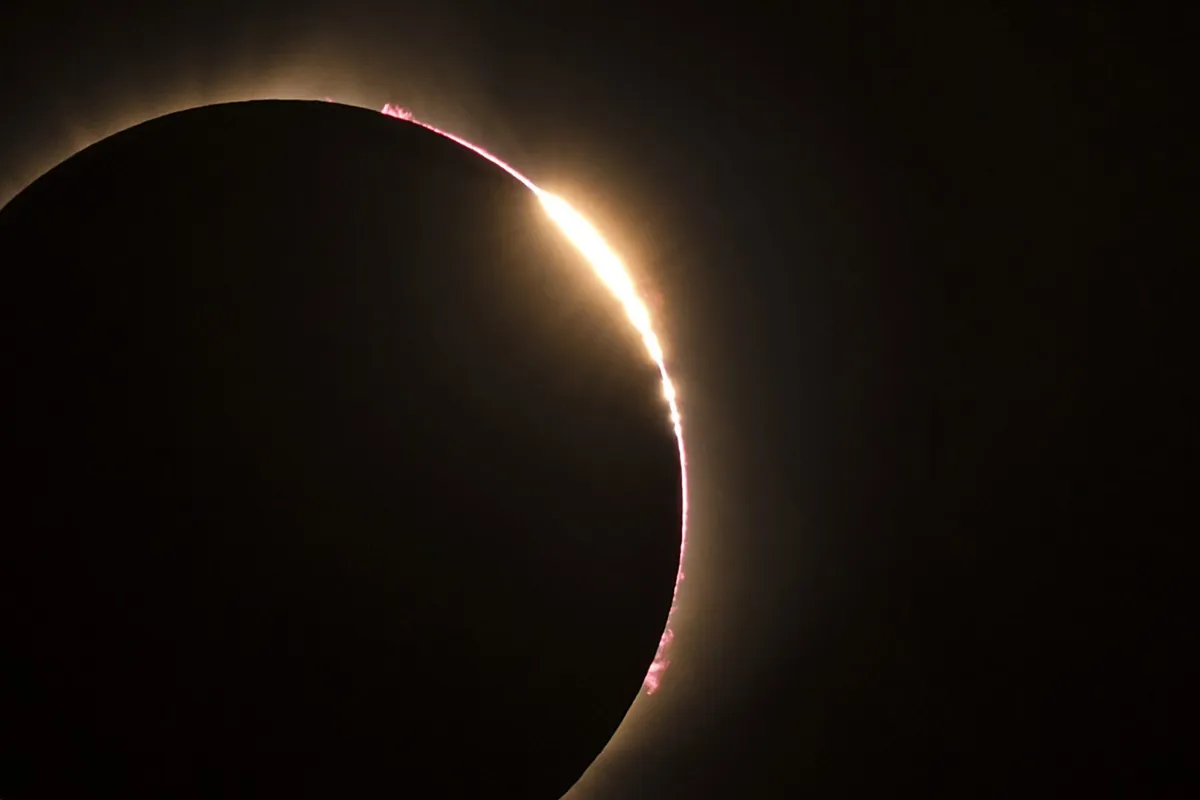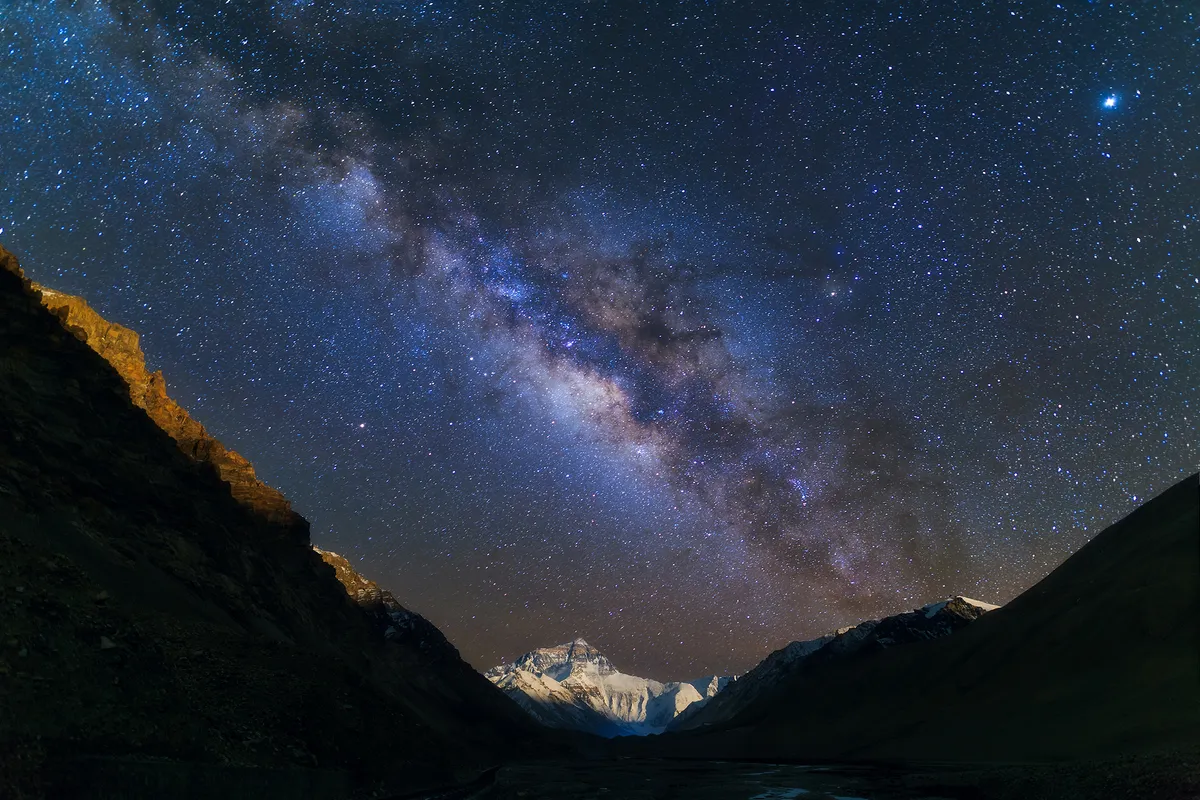Have you ever seen an annular solar eclipse? On Sunday 21 June 2020, those standing under a narrow path of annularity across Africa, the Middle East and Asia will get the chance to see a so-called 'ring of fire' eclipse as the Moon temporarily blocks out most (but not all) of the Sun’s disc.
Annular eclipses are normally not particularly rare – the last one occurred on Boxing Day in 2019 – but June's annular solar eclipse is extra special. The next one is the solar eclipse of 10 June 2021.
The solar corona is the Sun’s hotter outer atmosphere, and generally speaking it’s hidden from view by the brightness of the Sun’s disc.
It occasionally becomes visible to the naked eye during a total solar eclipse, when the Moon fits perfectly across the disc of the Sun, therefore allowing the corona to shine. It’s one of the greatest sights in nature, let alone in astronomy.
During totality it’s also possible to see the Sun’s chromosphere, its inner red atmosphere, and ‘Baily’s beads’ – bright spots of sunlight that shine through the valleys of the Moon.
All of that usually applies only to a total solar eclipse. However, June’s annular solar eclipse – an event not normally known for anything other than offering a uniform view of a ring around the Moon – will be unusual because of a rare quirk of celestial geometry.

How to watch the annular solar eclipse online
The eclipse is being live-streamed by timeanddate.com. Watch it below.
How do astronomers know when eclipses are going to happen?
Astronomers can pinpoint the time and location of the next eclipse to the millisecond.
“What you need is to have an accurate ephemeris, a computer program that can accurately predict where the Sun and Moon are, with respect to Earth,” says Fred Espenak, a NASA Scientist Emeritus best known for his work on eclipse predictions, who runs the website MrEclipse.com.
That means knowing where all three celestial bodies are in three dimensions. “Then you can predict where the Moon shadow is, since it’s always pointing away from the Sun.”
Figuring out where that shadow is in space, where it’s going to be, when it’s going to intersect Earth’s surface, and how it moves across the surface – all in 3D – is then calculated using spherical trigonometry.
“It’s all worked out by computer programs, but the techniques for calculating eclipses were worked out several hundred years ago,” says Espenak.
“Back then they were doing calculations using tables of logs and trig functions. It was done by hand, so it took a huge amount of time to calculate timings for one location.”
With the right type of software it now takes a fraction of a second.

Why will the 21 June annular eclipse be so special?
“This eclipse is nearly a total solar eclipse because the Moon is 99.5% the apparent diameter of the Sun,” explains Michael Zeiler, an eclipse chaser and cartographer who runs GreatAmericanEclipse.com.
“What is exceptional about this annular solar eclipse is that its very short duration allows for dramatic views of extended Baily’s beads and a brief view of the Sun’s chromosphere.
"The interplay of the Moon’s mountains and valleys against the narrow annulus ring of the Sun will be a spectacular sight through safe solar filters.”
From an observer’s point of view, that is the main difference between a total and an annular solar eclipse; the former allows you to remove protective solar eclipse glasses during the peak of the event, while the latter does not.
The special nature of June’s ring of fire means that eclipse-chasers’ trips to witness the event were being organised well in advance.
They’ve now been thrown into doubt by the COVID-19 pandemic, but at the time of writing some were still going ahead.

One expeditionary trip to see the spectacular event is being led by Dr Tyler Nordgren, an artist, astronomer, night sky ambassador and author of Sun Moon Earth.
“I’m looking forward to seeing Baily’s beads and all those little ‘edge effects’ as well as an incredibly thin ring, but I don’t entirely know what to expect because I’ve never seen an annular solar eclipse from this kind of altitude,” he says.
Nordgren’s group of eclipse chasers are planning to watch from close to Namtso, a lake north of Lhasa at a whopping height of 4,718m above sea level.
"The impressive thing about Tibet is that we’ll be looking through as little atmosphere as possible because it’s happening at a time of day when it’s very near noon, so the eclipse will occur when it’s high overhead."
Tibet is also one of the darkest locations on the planet, which makes it the perfect trip for stargazing since all solar eclipses by definition happen at the instance of new Moon.
"It should be one of the darkest nights we get to experience anywhere in the world," says Nordgren of this group’s plans to camp out the night before the eclipse.
"I’m really looking forward to seeing the summer Milky Way from that altitude."
Nordgren and his group will experience a mere 23 seconds of annularity. Why so brief? It’s to do with the Moon’s elliptical orbit of Earth.
"Sometimes it’s a little closer to Earth and sometimes it’s a little farther away, and that difference of about 10% is the difference between the Moon being able to fully cover the Sun during the eclipse and it being just slightly far enough away that it appears too small to block out the Sun – a perfect alignment," says Nordgren.
"That ring of Sun that’s not obscured by the Moon, and still visible during that perfect alignment can be any thickness, and in the case of this eclipse, that alignment happens when the Moon will be just barely too small to cover the Sun, so we’ll see an incredibly thin ring."

As a consequence of the ring being very thin the perfect alignment is incredibly short.
"That’s what makes this eclipse so interesting because the shadowed edge of the Moon just grazes the edge of the Sun," says Nordgren.
Despite the scientific rarity of this eclipse, Nordgren will watch it without optical equipment save for solar eclipse glasses.
"I really want to avoid looking at an eclipse through a camera or through a telescope because it’s a whole world experience," he says, adding that the glow of the sky around the horizon (safe to view with the naked-eye, of course) and the changing hues of the surrounding landscape are just as impactful as studying the ‘ring of fire’ itself.
"My personal feeling is that these eclipses are so much more impressive in a 180° view of the sky," he says.
Although Tibet is favoured for its dramatic view of a very thin annulus, there are other prime locations.
The ring of fire is visible at sunrise in the Republic of the Congo and the Democratic Republic of the Congo, then as a higher-in-the-sky spectacle in South Sudan, Ethiopia, Eritrea, Yemen, Oman, Pakistan, India, Tibet, China and Taiwan, with a ring of fire sunset in the Pacific Ocean south of Guam.
Meanwhile, a big partial solar eclipse will be visible across much of Africa and Asia.
"Many eclipse chasers will choose Quriyat in Oman because of the near-certain prospect of clear skies and easy access through Muscat," says Zeiler.
Another favoured location for organised trips – though largely for those after an eclipse in tourist-friendly surroundings – is Lalibela in Ethiopia, which is famous for its rock-cut monolithic churches.
However, astro-tourism is not what serious eclipse chasing is about. For a total solar eclipse, observers tend to head for the centre of the path of totality to maximise the duration of totality.
For expeditionary eclipse chasers, that’s not the case with this event.
"For annular eclipses, and especially short duration eclipses, experienced eclipse chasers will choose a location near the north or south limit lines for a very precious few seconds of annularity," says Zeiler.
"By choosing such a location, an eclipse chaser will enjoy a stupendous view of the last bits of sunshine rolling about the Moon’s disc."

With proper photographic gear it will be possible to capture a great view of the Sun’s chromosphere, and perhaps a hint of the Sun’s corona, though great care will need to be taken.
"This eclipse will be so fleeting that observers will bring several dedicated telescopes and long lenses to record the spectacular evolution of this brief eclipse," says Zeiler.
Whether anyone gets to travel to see the super-slim ring of fire remains to be seen, but a huge swathe of the planet will, come June, be scrambling for solar eclipse glasses to take a peek.
It promises to be a huge event, which shouldn’t be taken for granted; the next one – on 10 June 2021 – occurs in ultra-remote regions of Canada, Greenland and Russia.
More proof that if you like your travel convenient and comfortable, think carefully before becoming an eclipse chaser.
This article originally appeared in the June 2020 issue of BBC Sky at Night Magazine.
